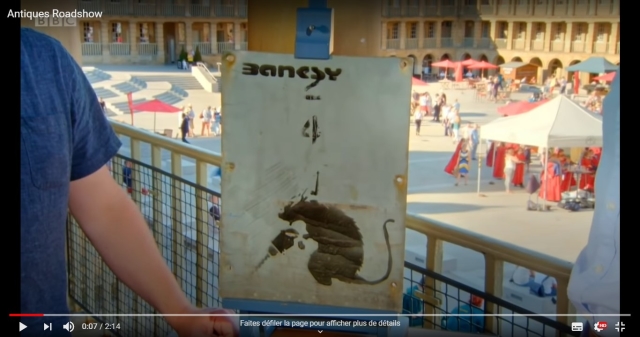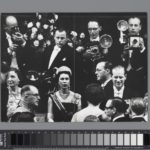
A bold, but unsuccessful attempt. A man recently appeared on the BBC’s TV series “Antiques Roadshow” to get an estimation on a previously-unseen artwork, which was purportedly created by Banksy. A piece of art, depicting a rat holding onto a power drill, that was removed in 2004 from a wall in Brighton, England.
The anonymous owner claimed he discovered the artwork while walking along the seafront in Brighton, where “it looked loose.”
“I went over, pulled it off basically,” he told Rupert Maas, an art specialist for “Antiques Roadshow.”
When asked about a certificate of authenticity for the piece, the owner explained he tried to obtain one in the past, but was told by Banksy’s Pest Control agency it could not be identified as an original piece.
Launched in 2008, Pest Control Office authenticates works attributed to Banksy and prevents fakes and site-specific street pieces from appearing on the market. Auction houses now sell pieces by the anonymous British street artist only with Pest Control certification.
Maas explained to the unidentified owner that the artwork would be very difficult to estimate without a certificate of authenticity delivered by Pest Control.
“I think the message here is that, if you do see a piece of graffiti art out there, leave it, leave it for the public. I’m not lecturing you. I’m just saying, without that certificate, it’s just very difficult to sell. With it, it might be worth £20,000. Without it, you’re nowhere,” he added.

Regulating Banksy’s market
While British TV viewers heavily criticized the man’s actions on social media, this is not the first time that a Banksy artwork appears in an episode of the BBC’s “Antiques Roadshow.”
“Mobile Lovers,” a mural depicting a man and woman distractedly gazing at their cell phones while in the middle of a passionate embrace, was valued at £400,000 ($670,000 or approx. P25.2 million) in 2014.
This artwork was initially spotted on a public wall in Bristol, although a local youth club known as Broad Plain Boys’ Club removed it with a crowbar “to prevent vandalism or damage being done” according to Artnet News.
Unlike the owner of the rat stencil, the Broad Plain Boys’ Club possessed a letter from Banksy, confirming the work as his own and officially giving it to the foundation. “I don’t normally admit to committing criminal damage, but seeing as it looks like charges won’t be brought any time soon you have my blessing to do what you feel is right with the piece,” the documents stated.
Banksy has gone to great lengths to regulate the market of his artworks in recent years. Last September, the street artist lost in a legal battle with a greeting card company and was refused a European Union trademark for his iconic artworks, “Flower Thrower.”
Pest Control applied in 2014 to the European Union’s intellectual property office to register the mural of a rioter hurling a floral bouquet as an official “trademark without text,” in an effort to protect it from commercial knockoffs. A contempt for intellectual property rights that was declared “invalid in its entirety” by the EU examiners.
“The contested (trademark) was filed in order for Banksy to have legal rights over the sign as he could not rely on copyright rights, but that is not a function of a trademark,” they wrote in their decision, adding that the graffitist’s choice to keep his identity concealed hurt his case. CC
RELATED STORIES:


